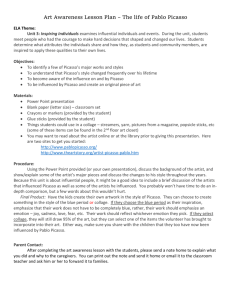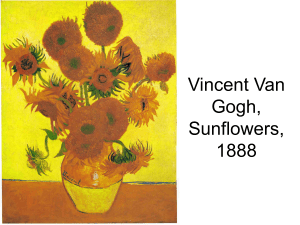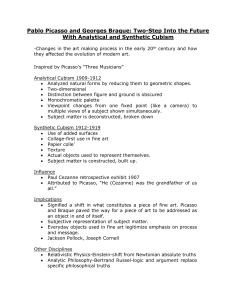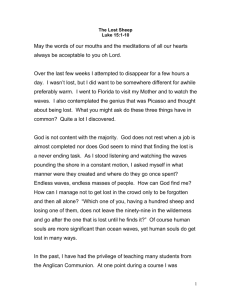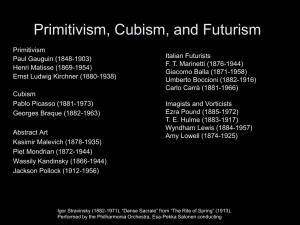domain-61dcbd846e.doc
advertisement
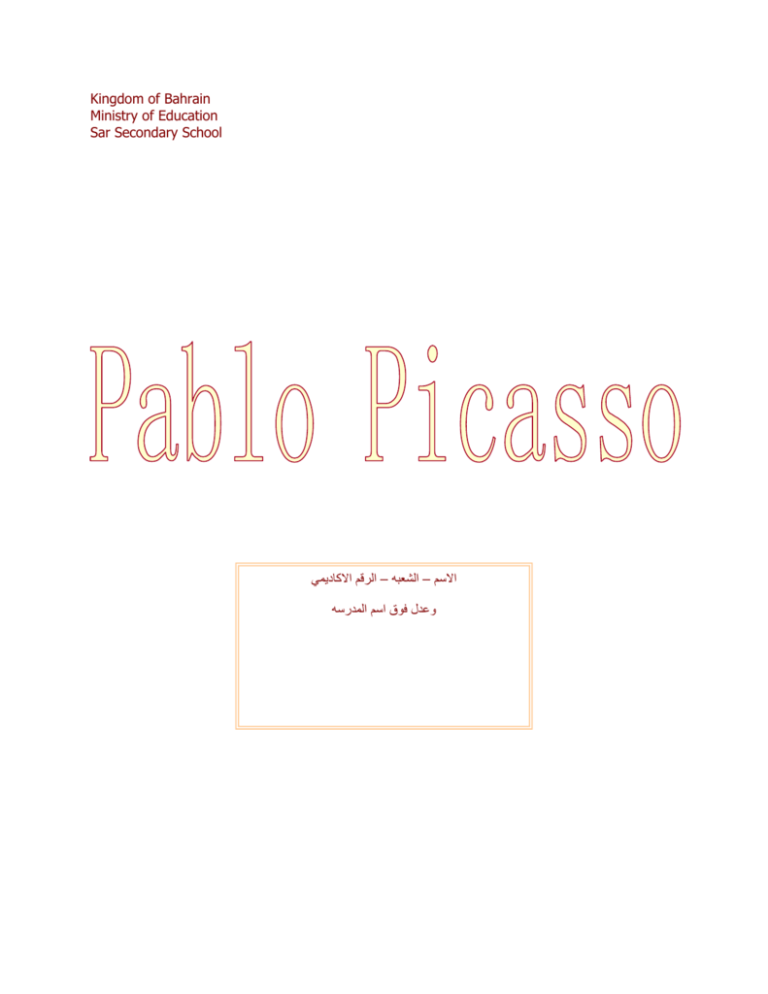
Kingdom of Bahrain Ministry of Education Sar Secondary School االسم – الشعبه – الرقم االكاديمي وعدل فوق اسم المدرسه Introduction This report is about the artist Pablo Picasso.. But who is Pablo Picasso?? Spanish painter Pablo Picasso (October 25, 1881-April 8, 1973) of the most famous painters of the world. Born in Malaga (Spain), and since his birth called him several names, including (Pablo Diego) and (Francesco Paola), did not keep the names of only the name (Pablo). The name (Picasso) took him from the name of his mother (Maria Picasso) and his father was named (Jose Ruiz Blasco), is a professor of painting and photography, and specialized in the design of birds and nature. The back of genius (Pablo) at an early age, and began to paint under the supervision of his father and his mother, when he was seven years old, learning from his mother, miscellaneous fees and oil painting. At the age of thirteen by Pablo supplement fee for the bathroom began his father's depiction Then he left was not supplemented and then joined directly at the Institute of Fine Arts, and passed the difficult test to be held for applicants for admission to the Institute, and completed after his Academy (San Fernando) for the Arts, then decided after that, and his father is sent to London to learn the art of British artists; but it is on the way to London stop in Paris in 1900 and then settled permanently in 1904 and settled to begin his journey of art. Cubism: "Then was the birth of Cubism, the beginning of a new phase in the history of contemporary art when Picasso Subscribe with Georges Braque in the same direction within the period of 1907-1909. Cubism was inspired by the study of Cézanne. With the study of primitive art. And African sculpture. The first of his paintings in the Covenant is a board INSAT Avignon 1907 Months of his plate (Jernica), (tragedy of Korea). Picasso demonstrated uncanny artistic talent in his early years, painting in a realistic manner through his childhood and adolescence; during the first decade of the twentieth century his style changed as he experimented with different theories, techniques, and ideas. His revolutionary artistic accomplishments brought him universal renown and immense fortune throughout his life, making him one of the best-known figures in twentieth century art. Before 1901 Picasso’s training under his father began before 1890. His progress can be traced in the collection of early works now held by the Museu Picasso in Barcelona, which provides one of the most comprehensive records extant of any major artist’s beginnings. During 1893 the juvenile quality of his earliest work falls away, and by 1894 his career as a painter can be said to have begun. The academic realism apparent in the works of the mid-1890s is well displayed in The First Communion (1896), a large composition that depicts his sister, Lola. In the same year, at the age of 14, he painted Portrait of Aunt Pepa, a vigorous and dramatic portrait that JuanEduardo Cirlot has called “without a doubt one of the greatest in the whole history of Spanish painting.” In 1897 his realism became tinged with Symbolist influence, in a series of landscape paintings rendered in non naturalistic violet and green tones. What some call his Modernist period (1899–1900) followed. His exposure to the work of Rossetti, Steinlen, Toulouse-Lautrec and Edvard Munch, combined with his admiration for favorite old masters such as El Greco, led Picasso to a personal version of modernism in his works of this period Career beginnings After studying art in Madrid, Picasso made his first trip to Paris in 1900, then the art capital of Europe. There, he met his first Parisian friend, the journalist and poet Max Jacob, who helped Picasso learn the language and its literature. Soon they shared an apartment; Max slept at night while Picasso slept during the day and worked at night. These were times of severe poverty, cold, and desperation. Much of his work was burned to keep the small room warm. During the first five months of 1901, Picasso lived in Madrid, where he and his anarchist friend Francisco de Asís Soler founded the magazine Arte Joven (Young Art), which published five issues. Soler solicited articles and Picasso illustrated the journal, mostly contributing grim cartoons depicting and sympathizing with the state of the poor. The first issue was published on 31 March 1901, by which time the artist had started to sign his work simply Picasso, while before he had signed Pablo Ruiz y Picasso. By 1905 Picasso became a favorite of the American art collectors Leo and Gertrude Stein. Their older brother Michael Stein and his wife Sarah also became collectors of his work. Picasso painted portraits of both Gertrude Stein and her nephew Allan Stein. Gertrude Stein became Picasso's principal patron, acquiring his drawings and paintings and exhibiting them in her informal Salon at her home in Paris. At one of her gatherings in 1905, he met Henri Matisse, who was to become a lifelong friend and rival. The Steins introduced him to Claribel Cone and her sister Etta who were American art collectors; they also began to acquire Picasso and Matisse's paintings. Eventually Leo Stein moved to Italy, and Michael and Sarah Stein became patrons of Matisse; while Gertrude Stein continued to collect Picasso. In 1907 Picasso joined the art gallery that had recently been opened in Paris by Daniel-Henry Kahnweiler. Kahnweiler was a German art historian, art collector who became one of the premier French art dealers of the 20th century. He became prominent in Paris beginning in 1907 for being among the first champions of Pablo Picasso, Georges Braque and Cubism. Kahnweiler championed burgeoning artists such as André Derain, Kees Van Dongen, Fernand Léger, Juan Gris, Maurice de Vlaminck and several others who had come from all over the globe to live and work in Montparnasse at the time. In Paris, Picasso entertained a distinguished coterie of friends in the Montmartre and Montparnasse quarters, including André Breton, poet Guillaume Apollinaire, writer Alfred Jarry, and Gertrude Stein. Apollinaire was arrested on suspicion of stealing the Mona Lisa from the Louvre in 1911. Apollonaire pointed to his friend Picasso, who was also brought in for questioning, but both were later exonerated. Personal life In the early 20th century, Picasso divided his time between Barcelona and Paris. In 1904, in the middle of a storm, he met Fernande Olivier, a Bohemian artist who became his mistress. Olivier appears in many of his Rose period paintings. After acquiring fame and some fortune, Picasso left Olivier for Marcelle Humbert, whom he called Eva Gouel. Picasso included declarations of his love for Eva in many Cubist works. Picasso was devastated by her premature death from illness at the age of 30 in 1915. After World War I, Picasso made a number of important relationships with figures associated with Serge Diaghilev's Ballets Russes. Among his friends during this period were Jean Cocteau, Jean Hugo, Juan Gris and others. In the summer of 1918, Picasso married Olga Khokhlova, a ballerina with Sergei Diaghilev’s troupe, for whom Picasso was designing a ballet, Parade, in Rome; and they spent their honeymoon in the villa near Biarritz of the glamorous Chilean art patron Eugenia Errázuriz. Khokhlova introduced Picasso to high society, formal dinner parties, and all the social niceties attendant on the life of the rich in 1920s Paris. The two had a son, Paulo, who would grow up to be a dissolute motorcycle racer and chauffeur to his father. Khokhlova’s insistence on social propriety clashed with Picasso’s bohemian tendencies and the two lived in a state of constant conflict. During the same period that Picasso collaborated with Diaghilev’s troup, he and Igor Stravinsky collaborated on Pulcinella in 1920. Picasso took the opportunity to make several drawings of the composer. In 1927 Picasso met 17-year-old Marie-Thérèse Walter and began a secret affair with her. Picasso’s marriage to Khokhlova soon ended in separation rather than divorce, as French law required an even division of property in the case of divorce, and Picasso did not want Khokhlova to have half his wealth. The two remained legally married until Khokhlova’s death in 1955. Picasso carried on a long-standing affair with MarieThérèse Walter and fathered a daughter, Maia, with her. MarieThérèse lived in the vain hope that Picasso would one day marry her, and hanged herself four years after Picasso’s death. Throughout his life Picasso maintained a number of mistresses in addition to his wife or primary partner. Picasso was married twice and had four children by three women. The photographer and painter Dora Maar was also a constant companion and lover of Picasso. The two were closest in the late 1930s and early 1940s and it was Maar who documented the painting of Guernica Death Pablo Picasso died on 8 April 1973 in Mougins, France, while he and his wife Jacqueline entertained friends for dinner. His final words were “Drink to me, drink to my health, you know I can’t drink any more . He was interred at the Chateau of Vauvenargues near Aix-en-Provence, a property he had acquired in 1958 and occupied with Jacqueline between 1959 and 1962. Jacqueline Roque prevented his children Claude and Paloma from attending the funeral. Devastated and lonely after the death of Picasso, Jacqueline Roque took her own life by gunshot in 1986 when she was 60 years old. conclusion We chose to write about this person that a famous artist, in addition to his work that received a large turnout of people and his own way to express their art and connect the ideas of deep well. References Becht-Jördens, Gereon; Wehmeier, Peter M. (2003). Picasso und die christliche Ikonographie: Mutterbeziehung und künstlerische Position. Berlin: Dietrich Reimer Verlag. ISBN 9783496012726. http://books.google.com/books?id=vRzFAAAACAAJ. Retrieved 8 October 2010. Berger, John (1989). The success and failure of Picasso. Pantheon Books. ISBN 9780679722724. http://books.google.com/books?id=5T1QAAAAMAAJ. Retrieved 8 October 2010. Cirlot, Juan Eduardo (1972). Picasso, birth of a genius. New York and Washington: Praeger. http://books.google.com/books?id=MvjVAAAAMAAJ. Retrieved 8 October 2010. Cowling, Elizabeth; Mundy, Jennifer (1990). On classic ground: Picasso, Léger, de Chirico and the New Classicism, 1910-1930. London: Tate Gallery. ISBN 9781854370433. http://books.google.com/books?id=M-_pAAAAMAAJ. Retrieved 8 October 2010. Daix, Pierre (1994). Picasso: life and art. Icon Editions. ISBN 9780064302012. http://books.google.com/books?id=hYymPwAACAAJ. Retrieved 8 October 2010.


